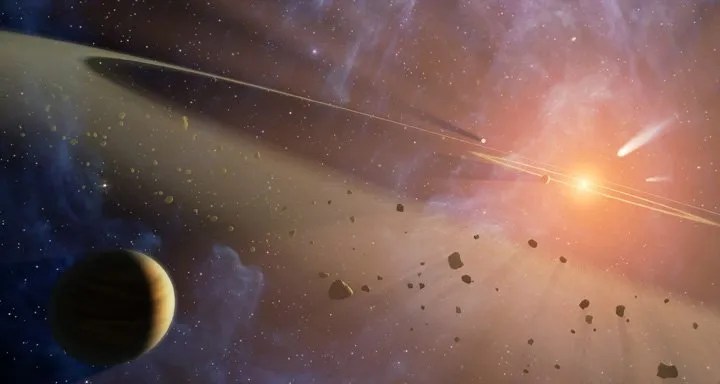There is a star system called Epsilon Eridani which is about ten light years away from our own. That means if you were to travel at the incredibly fast speed of light (that’s about 186,000 miles per second), it would still take you over ten years to get there.
Now, astronomers and sci-fi geeks like to nerd out over Epsilon Eridani because A) it’s relatively close, as space goes, and B) the Epsilon Eridani star appears to have asteroid belts and debris discs and, very likely, planets not unlike our own system’s.
There’s a third reason that’s a bit more philosophical, and that’s the impression that in Epsilon Eridani, we’re looking at a younger version of our own solar system. A star surrounded by a collection of astral bodies, dust and debris that, when considered on the whole, seem like they look and are developing just like our sun and planets did.
There are striking similarities in how the rings and debris that we see now, in Epsilon Eridani, appear to be the fresh leftovers from planets forming, similar to the rings and debris we find in our own solar system, such as our asteroid belt. Epsilon Eridani is just messier, less developed, less used to it’s new planets.
Like a house that’s been constructed and they haven’t yet cleaned everything up so there’s still wood shavings and bits of carpet and tools strewn around the place. A bit of tidying and staging and young Epsilon Eridani will look like it’s ready for new occupants.
But there’s something else interesting about Epsilon Eridani, at least to me, related to the fact that it’s 10 light years away.
You see, while light travels incredibly, imperceptibly fast, the distances in space are so vast, an Earth-bound measurement like miles or feet just doesn’t make sense. Even the distance to our own sun, ~92,000,000 miles, just isn’t fathomable to a dirt-attached guy like me. And that’s one of the closest objects to us! So we use light as a brilliant yard stick, marking off hundreds of thousands of miles in the moment it takes you to read a syllable.
But there’s a catch. A mind-blowing reality, if you will, that makes it even more challenging to comprehend distances in space.
All you see is the past.
When we gaze up at the heavens and stare at that starry canvas, our eyes are seeing light from billions and billions of stars. Like everything else we see, our minds process the light and information and understand it to be a star, or perhaps a planet, or maybe even a distant galaxy. Yet because we’re dependent on using our eyes to process the light that is emitted from those stars, and it takes light one year to travel a light year, the light you see tonight when you walk outside and look up at Epsilon Eridani is ten years old.
Those rays of starlight left Epsilon Eridani 10.5 years ago and are just now arriving here on Earth.
Which means if you could discern more than just a white dot… if you could make out those asteroid belts and debris fields… what you would be doing is looking into the past. You’d see Epsilon Eridani not as it is, but as it was, ten years ago by our count.
You would see Epsilon Eridani as it actually existed on the night of Saturday, October 30th, 2010, when a young couple in St. Louis spent the day surrounded by friends and family to celebrate their marriage. As young(ish) planets swirled around Epsilon Eridani and soaked up it’s radiation, my bride, Eva, and I, swirled and danced through Sheldon Hall and soaked up toasts and wedding cake in equal measure.





You would have seen how excited we were to begin our journey together, orbiting around each other and strolling through the galaxy like twin stars.
In the years since, we’ve been blessed to have two beautiful girls join our familial system, which means tonight we get to celebrate an anniversary of love and formation. Just like looking at the night sky, we’re seeing what’s already happened, what already existed, and cannot know for sure what tomorrow will bring, so to do we celebrate births and weddings that have happened in the past. Yet we celebrate not only what we’ve experienced and cherished, but the promise of what’s yet to come.
The promise of continued love and support and fun and adventure. A hope fulfilled just as every nightfall is filled with brilliant stars that span the horizon.
When I look at my bride, just as when I stare up into space, I am filled with hope and excitement for what is yet to come. I see dreams of projects and vacations and rich experiences. I see days and nights spent teaching and nurturing and laughing with our children. And I see a partner with whom to lock arms as we continue our interstellar journey.
All I see is the future.
Your loving husband.


 We Whisper Too Quietly on Social Media
We Whisper Too Quietly on Social Media